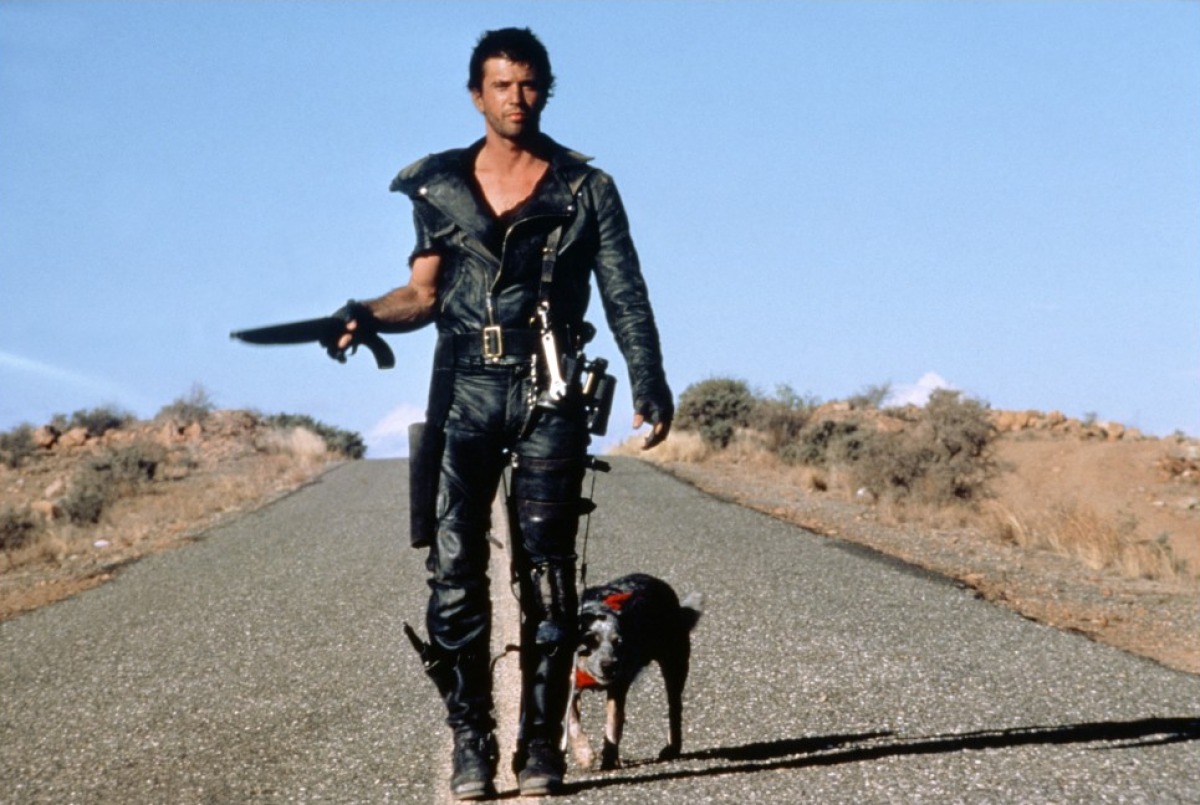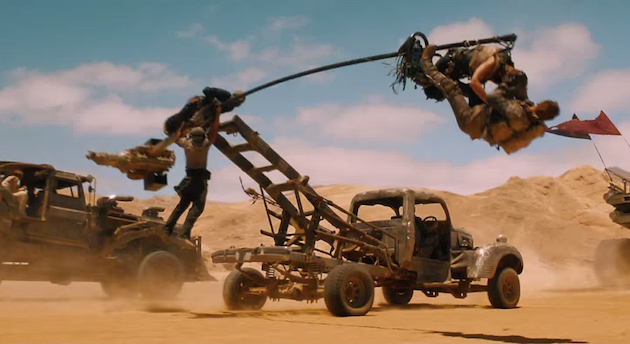The Road Western: The Mad Max Series and its Latest Installment, Fury Road
Post by Colleen Glenn, College of Charleston
The Road Warrior (1981), the second of George Miller’s Mad Max series, opens with a voiceover (The Feral Kid) explaining how a global war for fuel-toppled nations and decimated the earth, leaving only an empty wasteland, where survivors compete for precious resources in a life-or-death struggle. “Footage” depicts talking-head politicians, images of the massive war (uncannily familiar, as they resemble images from WWII), and, finally, the result: total anarchy, in which gangs terrorize the highways, killing innocent “civilians” for fuel. The sequence ends with an image of the film’s hero, Max (Mel Gibson), standing alone on the empty road in his boots and black leathers, larger-than-life in the boy’s memory. The latest installment of the series, Mad Max: Fury Road (2015), employs a voiceover at the film’s opening as well, but this time the voice belongs to Max (Tom Hardy), haunted by his dead daughter, as he explains the one remaining goal after the collapse of civilization: survival. Like Mad Max (1979) and The Road Warrior, Fury Road returns the franchise to the road and to its drivers, reinvigorating the cult series with forceful energy, spectacular chases, and breath-taking imagery.[i]
Though it’s a sci-fi-fantasy series set in the future, Miller’s films draw heavily upon conventions and motifs of the Hollywood western and the road movie, grounding the post-apocalyptic fantasy-nightmare plot in the familiar mythos of the American frontier, yet complicating and updating it in significant ways. It is that graceful melding of the past, present, and future—even in the low budget, sometimes-clunky original movies—that gives the imaginative Mad Max franchise its continuous import and allure.
Mad Max as Western
Much like the western cowboy hero, Max is a loner, a man with a violent past, who travels alone and acts according to his own moral compass, which eventually guides him to help the community of settlers who cannot adequately defend themselves. The series also employs the aesthetics and stage of the open frontier (noticeably bleaker in the Australian-made Max movies); villains who desire all of the resources for themselves (as in Shane (1953), complete with adoring boy); and the sense that it is in this open, unsettled space that our collective future will be determined. In Beyond Thunderdome (1985), the western motifs become paramount—and problematic—as Max encounters a sleazy, corrupt settlement and naïve, helpless tribal characters that resemble Native Americans/Aboriginals, with headdresses, spears, and mohawks.
Interestingly, the Mad Max movies have more in common with spaghetti westerns than Hollywood westerns. Far more cynical than Hollywood westerns, spaghetti westerns, primarily made by European directors in the 1960s and ’70s, are laden with irony and with quirky characters; feature tough-as-nails, anti-social anti-heroes (Max is even introduced as “The Man with No Name” in Thunderdome, a clear reference to Clint Eastwood in the Sergio Leone westerns); and tend to be highly violent, with endings that resist full resolution. The Mad Max series fits this rubric, with its nearly silent, stoic stars, oil rigs that turn out to be filled with sand, graphic displays of violence, and ambiguous conclusions that necessitate sequels. Like the spaghetti western, then, Miller’s series both borrows from and undermines its genre, in this case, the road film, toppling its ideology and offering a drastically bleaker vision of what the road represents.
Mad Max as Road Movie
In the Hollywood road movie, a direct descendant of the western, the open road substitutes for the American frontier. Like the West, the road in such films and texts (Easy Rider, Thelma and Louise, On the Road) promises opportunity, freedom, and renewal, though it rarely delivers on these promises. Traditional road films typically begin with a tremendous sense of excitement and energy as the drivers take the road (cue Steppenwolf), but end in horrific displays of death and destruction as the road becomes a site of danger or runs out altogether. Although the horrific destruction at the end of these American films may belie a sense of anxiety regarding unfettered freedom, the road does lead somewhere, and its travelers usually evolve along the way.[ii]
In the Mad Max series, however, the road appears more circular than linear, leading nowhere in particular, or sometimes right back to where it started, begging the question as to what purpose the journey—and the great death toll along the way—served. Stretching through a desert wasteland where few destinations remain in the post-apocalyptic landscape, the road in these films functions less as a path and more as a nihilistic, never-ending battlefield, where survivors of the global war compete for precious natural resources and the war boys gladly sacrifice their lives for the glory of Valhalla/God. In Miller’s first film, Mad Max, the road battles are even more gruesome, as a sociopathic biker gang (taking a page from Brando’s gang in The Wild One (1950)), kills and rapes along the highway for no other purpose than amusement.
Whereas in Hollywood road movies, the drivers run into danger when they get off the road (typically in the form of ignorant, dangerous rednecks, i.e., people who have not traveled enough), in the Mad Max films, as seen in the thrilling, grisly chase sequences, the protagonists are most vulnerable while on the road. But as there is nothing valuable off the road, the road remains the only impossible possibility, and the sense of the road as connecting places dissipates into an understanding of the earth as a nearly monolithic desert. In Fury Road, after discovering the Green Place is no longer habitable, Imperator Furiosa (Charlize Theron), taking Max’s advice, turns the rig around, retracing the hard-slogged steps to return to The Citadel, their original point of departure. Such pessimistic portrayals of the road across the series dismantle the Hollywood road film’s mythos of possibility, infusing the genre with grim, contemporary concerns regarding the downward spiral of environmental abuse and potential global annihilation.[iii]
Just as Miller’s first three films referenced the 1970s fuel crisis and predicted a global war for oil, Fury Road bears unmistakable allusions to the ongoing war in the Middle East, where the West is engaged in an interminable battle for influence—and fuel—against extremists waging a holy war. The road as battlefield rather than frontier alters not only the purpose of the journey, but also its travelers, who are more accurately warriors in Miller’s road films than drivers. Indeed, Aunty Emity (Tina Turner) calls Max a “soldier” at the end of Thunderdome (recall Max is a rogue Special-Ops cop in the first film). The series offers a gendered account of warfare and the roles men, women, and children play in warzones; updating this, Fury Road takes the feminist characters from the previous films and creates the strongest female warrior of the series yet, Furiosa, who, is equal to or even dominant to Max. The films also portray consequences of warfare, not just in the wasted landscape and the high body count, but also in the many orphaned children that populate the series, and in Fury Road, the female sex workers.
Praising Fury Road, Anthony Lane of The New Yorker recently claimed that the original series doesn’t hold up.[iv] But I don’t agree: while Thunderdome undeniably strayed too far from the formula, his comment overlooks the first two films, especially The Road Warrior, which remains, even after the latest installment, perhaps the strongest of the series because of its masterful pacing. Recognizing Road Warrior‘s superiority to the other two, Fury Road‘s creators stuck closest to it, keeping the dialogue to a minimum and adding beautifully stark scenery and a helpful explanation of the war boys’ devotion to their tyrannical leader and his cause. The series continues to be a cult classic not only because of its apocalyptic sci-fi scenario and delightfully campy aesthetics, but also because the series re-appropriates two strong generic traditions, the western and the road movie, and redeploys them to create an environmentally catastrophic vision of the future that we—and our shortsighted ideologies—could create.
[i] Mad Max: Beyond Thunderdome (1985) took an unfortunate turn off the road, setting most of its story in settlements, and only resumes the compelling energy of the series during the final chase sequence.
[ii] For an in-depth analysis of the road movie and its evolution over time, see David Laderman’s Driving Visions (Austin: U of Texas P, 2002) and Steven Cohan and Ina Rae Hark, The Road Movie Book (New York: Routledge UP, 1997).
[iii] Certainly, other road films, notably Two-Lane Blacktop (1971) and Paris, Texas (1984), portray the road as lacking hope, rather than promising it, but Miller’s series contains more specific, contemporary political allusions.
[iv] Anthony Lane, “High Gear: Mad Max: Fury Road,” The New Yorker, May 25, 2015, http://www.newyorker.com/magazine/2015/05/25/high-gear-current-cinema-anthony-lane





Great article! Love the comparisons. Can’t wait to read more from you Colleen!